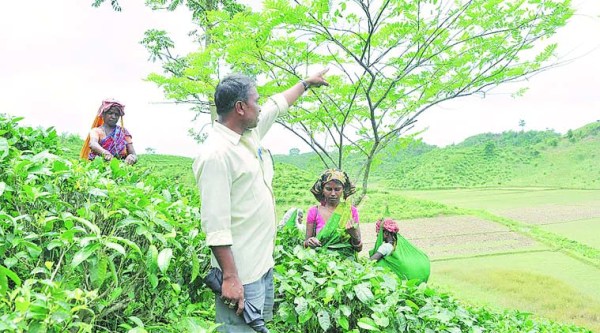- India
- International
Postcards of change: The tea point
A tea estate finds itself in Bangladesh after the boundary pact. A village prepares for morning after.
 A employee of Madanpur tea garden point his finger towards the Madanpur Tea garden from the Madanpur tea garden which is out side the fence at Indo Bangladesh Border in Karimganj of Assam on Friday 15th May 2015.With the Indo Bangla land swap deal , the Madanpur tea garden area which is out side the fence will go to Bangladesh. (Express Photo by DASARATH DEKA
A employee of Madanpur tea garden point his finger towards the Madanpur Tea garden from the Madanpur tea garden which is out side the fence at Indo Bangladesh Border in Karimganj of Assam on Friday 15th May 2015.With the Indo Bangla land swap deal , the Madanpur tea garden area which is out side the fence will go to Bangladesh. (Express Photo by DASARATH DEKA
What she will miss the most is the scent. For 40 years, Shefali Bhumij has been working in the Madanpur tea estate in Madanpur village of Assam’s Karimganj district. On May 11, with Parliament passing the 100th Constitution Amendment Bill formalising the Land Boundary Agreement between India and Bangladesh, the “best part” of the tea estate went to the other side.
“The tender leaves in that section (Section 13-A) were very soft. I bet their scent is sweeter than the tea bushes this side,” says the 56-year-old. Born in Line No. 2 of the tea estate’s labour lines, Shefali was “around 16” when her mother got her enrolled as a labourer too. “She showed me how to hold two leaves with the bud in between and twist the fingers to pluck it off without hurting the tea bush,” she remembers.
Exactly 268.93 acres in Assam — said to be under “adverse possession” of Bangladesh — will now be formally transferred. Of this 193.85 acres is in Boroibari in Dhubri district (to move to Kurigram district of Bangladesh) and 74.54 acres is in Madanpur-Pallathal in Karimganj district (now to be in Bangladesh’s Sylhet).
The Madanpur tea estate is owned by the Kolkata-based All India Tea & Trading Company, which also owns estates in Jalalnagar and Balacherra. Madanpur and Jalalnagar are right on the India-Bangladesh boundary.
According to Article 3(d)(ii) of the LBA protocol, “The boundary shall be drawn from existing Boundary Pillar No 1370/3-S to 1371/6-S to follow the outer edge of the tea garden and from Boundary Pillar No 1372 to 1373/2-S along the outer edge of the plantation.” But, according to the tea company, the boundary appears to have been drawn straight from one pillar to another, cutting right through the Madanpur estate.

Lamenting the loss of more than 79 acres falling under Section 13-A, senior estate manager S Purakayastha says they had only in 2010 replanted new tea saplings there under a programme that then Union commerce minister Jairam Ramesh initiated to boost the flailing Indian tea industry.
“All that effort and money have gone to waste. While a portion of that section, measuring about 79 acres, has gone to Bangladesh, another portion (150 metres wide and about 700 metres long) now lies between the barbed wire fence and the actual line of boundary pillars. To tend that portion, we must send our labourers through two gates manned by the BSF, with the people required to return by a specified time before sunset,” Purakayastha says. “Tea bushes cannot grow according to the BSF’s timing.”
Adds Jose Mukkathu, the Kolkata-based director of the tea company, “I personally met Jairam Ramesh and sent representations to then prime minister, external affairs minister and home minister (to stop the transfer of the land), but there was no response.”
The production in the estate, which the present owner’s family purchased way back in 1912, till about five years ago was about 4.5 lakh kg tea leaves per annum. With Section 13-A gone, it is estimated to produce less than 4 lakh kg.
Rupak Ranjan Pal (48), the supervisor (called tilla-babu), says, “Our workers used to go to Section 13-A every day until, in September 2011, the local BSF commandant told us it would now become part of Bangladesh. A few weeks later, the barbed-wire fence came up right through that section. But even then, we used to send labourers out to work. Now our management has asked us to stop.”
Jethu Rikiason, section chowkidar for Section 13-A, feels almost jobless. “I have given the best years of my life to Section 13-A. Today I look after the small portion of that section which is inside the fence.”
Purakayastha feels lucky that their labour lines were not in the portion that has now gone to Bangladesh. The estate’s 200-plus labourers live in the two labour lines, with the company providing them drinking water, toilets and rations.
Around 90 students study in the lone primary school, run by two teachers. However, once they have cleared primary school, students have to travel around 9 km to the nearest high school, which is in Gandai.
Besides, the Madanpur tea estate is ailing, with recruitment on hold for eight to 10 years, and a split may prove costly. “The factory was shut in 2001. Now we only produce green tea leaves and sell them to the Gambhira tea estate nearby,” says Purakayastha.
Allaying fears that the estate may be shut too, he adds, “Madanpur tea, though no longer sold under its name, definitely fetches a good price in the market.”
Labourers have another worry. “Traditionally our children work in tea estates. I myself am a third generation born here. But now only one of my two sons has found a job in the tea estate, that too as contract labourer,” says Ramu Bhumij (65), the head labourer. “How will he find a job outside if he has only studied up to Class V?”
Apr 26: Latest News
- 01
- 02
- 03
- 04
- 05







































